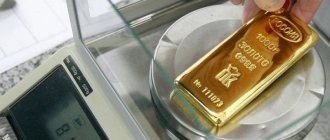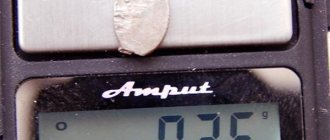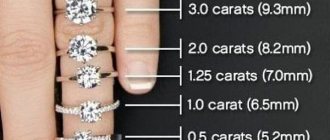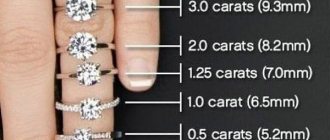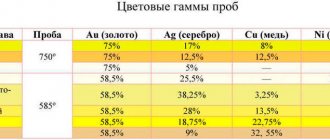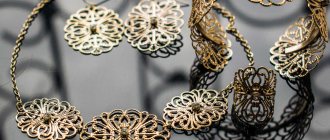The reference weights have changed recently. Before this, people used other units. Moreover, for each type of thing there were its own measurements. Numismatists, for example, often come across the following phrases: “4 spools and 55 shares” or “2 spools and 99 shares” when it comes to banknotes from the times of the Russian Empire. And today we use the proverb “small spool, but expensive.” Therefore, you should know that the spool is a measure of weight that is equivalent to 4.266 grams, or 1/96th of a pound.
This unit was used in relation to the weight of a gold coin. That's where the name came from. Moreover, spools appeared even earlier, in Kievan Rus. The coin was unremarkable in appearance, except that it consisted of 96 shares, and not one hundred, as is customary now.
Weight measure - spool
But this situation can be explained by the weight of the pound, as well as the six-digit counting system in those days. It is believed that the first example of a spool was a coin issued during the reign of Vladimir the Great in Rus'. It weighed about four grams. Therefore, citizens never had the question: how much is one spool? There are only ten such copies left, and all of them are in museums.
In Dahl's dictionary
m. brocade sundress, gold women's clothing. | Iron pyrite, which people consider to be gold ore. | Gullet in pumps; a plate with a weight on the steam engine tube, in steam engines, from where excessively raised steam bursts out. | Weight, three per lot, 96 per pound, and a weight of that weight. The spool is small, but heavy. And the spool is small, but expensive. The spool is small, but it weighs gold; the camel is large, but it carries water. Not a share in pounds, a share in spools. Trouble comes in pounds and goes away in gold. | Uterus, female womb, Uterus. | Powder, anus, Anus. | Plant. Potentilla hirta; | plant spool grass, centaury, Erythrea centaureum. | Plant. Galeopsis ladanum, stinking chicken coop, nursery. Zolotnik novg. brocade sundress; | sulfur pyrite. In these two meanings. this emphasis is more correct. Zlatnik, plant. Asphodelus ramosus, oxtail, turban, goldenrod, king's spear. Spool or spool, related to the spool; | weighing a spool. Spool weight. - lever, in the car. Spool goods, threads, thin, expensive, sold for spools. Zolotnikov's head, shifting grass, goldenrod, plant. Parnassia, belozor. Zolotyanka thin gilded wire. Gold, gold, grain of gold, sparkle in the mine. To gild something, to cover it with a solution, a mixture of gold or gold leaves; silver and copper are gilded in the first way, wood and paper in the second. Not everything is gilded, different and plain. The bow is gilded, the harness is belted, and the horse is not fed. -sya, to be gilded, gilded, and to become gilded, to become golden, to take on a golden appearance, color. The fields are turning golden, turning golden from afar, seeming golden. Golden Wed. duration valid by value verb gild. Gilding Psk. hard impersonal study early. It's already gilded in the east. Gilding, related to gilding, gilding. Goldsmith an establishment, a workshop where gold is made. Goldsmith m. goldsmith f. goldsmith, gilder, who gilds. Goldsmith, goldsmith. Zolotar m. wood gilder. | Sib. gold miner. | Otkhodnik, southern parachute Golden, related to the goldsmith's craft, belonging. Zolotarnya w. gilding Goldenrod m. sib. acacia species, small tree Robinia (Caragana) pygmea; jew; C. arborescens, pea tree. | Plant scrofula, goldenrod, scrofula, goldenrod, boneweed, life-giving, ironweed, Solidago virgo aurea. Goldsmithing, earning a living from the outside by cleaning latrines. Golden thief. plant Thalictrum (Naumov). Scrofula a congenital disease of thinness, in which the glands are especially ill; Psk. nobility, Scrofulae. | Plant. yellow nightshade, Solanum dulcamara. | Plant. Gnaphalium sylvaticum, desert squirrel. | Plant. Solidago virgo aurea, ironweed. | Plant. narrow Luputa, meadow rue, Thalictrum. | Convoy of Siberian gold. | All the post horses were taken away due to scrofula. Scrofulous, related to scrofula; suffering from it, obsessed with it. Scrofula herb, plant. Kochia orenaria. | Filago, see toadgrass. | Cynoglossum, see larkspur. | Ivan da Marya, Melampyrum nemorosum. Scrofulous, the same, meaning. inclinations, dispositions towards this disease. Scrofulus, plant. coil. | Inula britannica plant. | Plant. upland ironweed. Zolotarevka, Zolotarevsky apple; quite a large breed, with light kvass; a whitish, fragile apple, akin to titovka, gusevka, finger. Gold-beater, gold-beater, who makes sheet, gilded gold. Gold-beating, gold-piercing, related to this craft. Golden sparkle, golden sparkle, also golden sparkle, aventurine stone. Gold(gold)brow m. fish Sparus aurata. Golden-browed, golden-browed, who has golden, golden eyebrows. Golden-topped (or golden-topped), golden-poppy, with a gilded top, head, dialect. esp. about churches; *Orthodox, ancient city; own Moscow. Golden (golden)-visible, golden-like, golden-like, gold-like, golden-sighted, golden in appearance. Golden-haired, golden-haired, who has golden hair. Goldilocks, goldenhair, golden-headed or golden-headed w. goldenhair plant Crysocoma, as well as | Lilium bulbiferum. Golden-headed, golden-headed, golden-domed. Goldenrod m. plant. Asphodelus ramosus, goldenrod. Golden-voiced, sweet-voiced. Gold-drawing mill, gold-drawing mill. an establishment for making bits and pieces. Gold-drawing, generally related to this matter. Golden-breasted man-at-arms, a bird with a golden chest. Goldsmithing Wed. the work of a goldsmith, goldsmith; | the art of making gold, which was practiced in ancient times by alchemists. Goldsmith m. goldsmith; | alchemist. Golden yellow tree from the plum family, Chrysobalanus.
Weight unit conversions
In addition to this unit, there were other names applicable to larger weights of things. The system consisted of the following units:
- Puda. The pud as a Russian measure of weight was the largest indicator. It was 40 pounds. Of course, there were more than a pound of Berkovites, but they were not used in everyday life.
- Pound. In turn, one pound corresponded to 32 lots or was transferred immediately and amounted to 96 spools.
- Lotta. One lot was equal to three spools.
Such translations were easy to understand even for ordinary people in Rus'. Therefore, they were used quite often, and references to units of measurement are found in the sources of that time. Now the information is found in numismatic catalogs. And with the help of proportion, you can now easily find out how much the spool weighs.
How was the unit of weight used?
The spool was also used to indicate the purity of the gold in the coin. The thing is that coins were often produced in a lower standard than 999. This was due to the fact that the precious metal in its pure form has a soft, plastic consistency. Such money quickly wears out in everyday life and loses its attractive appearance. Therefore, it was worth adding a ligature, that is, other metals, to the coins in order to preserve the circulation longer.
In the old days, samples were counted using a spool. Since the weight measure consisted of 96 parts, if it contained 70 parts of precious metal and 26 parts of the ligature, it was written like this: “70-spool gold.” Now the sample is calculated as a percentage or in carats.
And the very concept of measure was preserved even during the Soviet Union. It was applied to the gold chervonets “Sower”, which were issued for external payments of the state in 1932, 1975–1982. Of course, no one measured precious metal in this way anymore; it was all a formality or a tribute to tradition. It is believed that the mass of pure metal in this money is 1 spool and 78 shares.
The smallest unit of weight was called shares. It was equal to 1/96 of the spool, or 44.4 milligrams according to modern calculations. Since the weight of coins was always carefully observed, money was used on scales as weights. Small products in pharmacies or markets were weighed using them.
The history of weights is very fascinating, and if a collector does not know how to convert to modern calculations, it can confuse him in the future. Today, the system has not been simplified too much, because instead of the usual grams, precious metals are measured in troy ounces.
Zolotnik: what is it?
The weight of one spool is 4.265 grams.
During the times of Kievan Rus, a gold coin weighing 4.265 grams (96 shares) was called a zolotnik. The spool was used to indicate the purity of gold. For example, a gold coin weighing one spool contained impurities from the mass of a gold-containing alloy (21 shares) and gold (75 shares). In this case, the coin was considered to be made of 75-carat gold—in other words, “75-spool gold.” The spool mass measure was also used to measure the amount of pure silver in coins.
The history of the appearance of the name spool
Today, scientists cannot say for sure where the very name of such a measure of weight as a spool came from. Presumably this name comes from the times of Kievan Rus. It is known that during the time of Prince Vladimir the Great (10th century), one of the small princely gold coins was called “zlatnik”.
Probably, later this coin began to be actively used as a weight when weighing products made of precious metals. And gradually, from the name of the coin, the “spool” got its name - a measure of weight used to determine the mass of a product made of
The first written mention of a spool as a measure of weight dates back to the 13th century. In one of his business documents, Prince Mstislav from Smolensk uses the word “zolotnik” not as the name of a coin, but as a measure of weight. It was probably during that period that the proportion of pure precious metal in a particular coin or other product made of gold and silver was measured with the help of spools.
Over time, the popularity of the spool as a measure of weight spread. And since 1711, the spool received the status of an official measure of weight not only for gold and silver, but also for other precious metals and was used until 1927.
There is also an alternative opinion that the word "spool" comes from the name of the metal gold. However, this is unlikely, since a spool was also used to measure the weight of platinum and silver.
This weight measure contributed to the emergence of the so-called spool sampling system, which was widespread in the Russian Empire.
Spool sampling system
This sampling system made it possible to determine the presence of precious metals in a particular alloy, as well as their quantity. In other words, the sample of the precious metal (its purity) was determined by the spool. This weight measure contributed to the formation of the spool and spool
So pure gold without impurities (now a precious metal weighing 96 spools was considered. This meant that if the composition of the metal is taken to be 100%, then all 100% gold. However, in the spool sampling system the maximum amount was not 100%, but 96 units of precious metal And if all 96 of them were gold, the metal was pure and had a purity of 96 (now 999).
The smallest spool standard was 56 (now 585), because it contains only 56 parts of gold, and the rest is impurities of other metals. In total, in the old days there were six spool samples of gold.
Today, happy owners of gold jewelry made before the revolution can notice the spool test of that period on them. To convert it into a modern system and find out the pure metal of the product, you can use the simplest formula: A/96*1000=B. In this case, A is a spool sample, and B is a modern one.
Measuring the purity of silver in spools was also not very different from gold. However, initially there were a larger number of samples of this metal - as many as nine (from 72 to 95). True, at the end of the 19th century they were significantly reduced to four (from 84 to 95).
As with gold, the silver spool helped determine the number of shares of this metal in 96 units. Today, you can convert the pre-revolutionary spool standard of silver into a modern one using the same formula as with gold.
Synonymous expressions
Today the meaning of the phrase is so obvious that replacing it with a synonym is not difficult. Choose any:
- a small bird, and a voice ringing;
- small and remote;
- The pot is small, but it cooks the meat;
- a small beast, but a paw;
- the fish is small and the fish soup is sweet.
Foreigners have the following options:
- small but good (German);
- little goes far (English);
- A small fish will grow into a big pike (French).
If we want to emphasize an additional shade of meaning, hinting that despite outward modesty and “smallness” a person is very businesslike and skilled, it is permissible to say: “It is not the gods who burn the pots.” Or in English: “Unnoticed blows fell great oaks.”
Both will be correct, because people greet you based on their clothes, and see them off based on their minds (or business). Appearances can be deceiving, all that glitters is not gold, but if you find a real gem, appreciate it, no matter how tiny it may seem!
